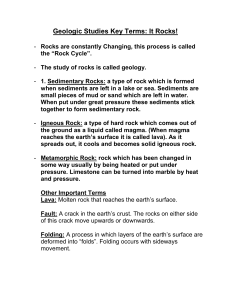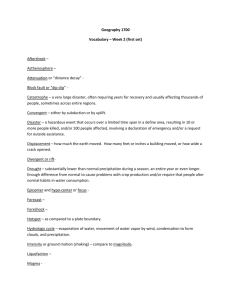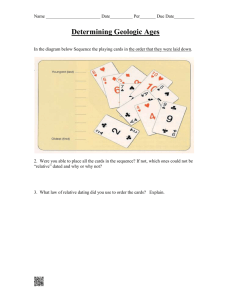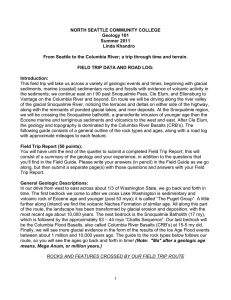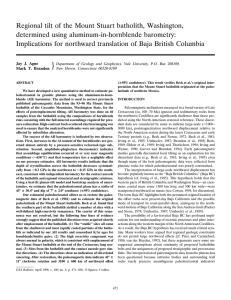FieldTripGuide2006
advertisement
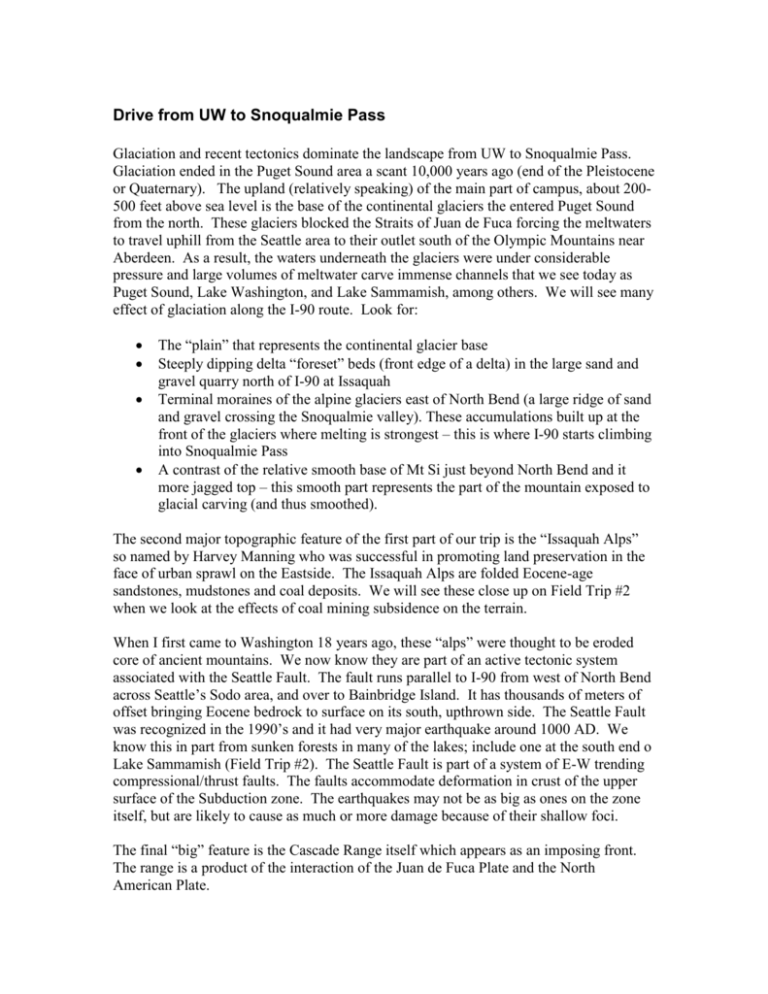
Drive from UW to Snoqualmie Pass Glaciation and recent tectonics dominate the landscape from UW to Snoqualmie Pass. Glaciation ended in the Puget Sound area a scant 10,000 years ago (end of the Pleistocene or Quaternary). The upland (relatively speaking) of the main part of campus, about 200500 feet above sea level is the base of the continental glaciers the entered Puget Sound from the north. These glaciers blocked the Straits of Juan de Fuca forcing the meltwaters to travel uphill from the Seattle area to their outlet south of the Olympic Mountains near Aberdeen. As a result, the waters underneath the glaciers were under considerable pressure and large volumes of meltwater carve immense channels that we see today as Puget Sound, Lake Washington, and Lake Sammamish, among others. We will see many effect of glaciation along the I-90 route. Look for: The “plain” that represents the continental glacier base Steeply dipping delta “foreset” beds (front edge of a delta) in the large sand and gravel quarry north of I-90 at Issaquah Terminal moraines of the alpine glaciers east of North Bend (a large ridge of sand and gravel crossing the Snoqualmie valley). These accumulations built up at the front of the glaciers where melting is strongest – this is where I-90 starts climbing into Snoqualmie Pass A contrast of the relative smooth base of Mt Si just beyond North Bend and it more jagged top – this smooth part represents the part of the mountain exposed to glacial carving (and thus smoothed). The second major topographic feature of the first part of our trip is the “Issaquah Alps” so named by Harvey Manning who was successful in promoting land preservation in the face of urban sprawl on the Eastside. The Issaquah Alps are folded Eocene-age sandstones, mudstones and coal deposits. We will see these close up on Field Trip #2 when we look at the effects of coal mining subsidence on the terrain. When I first came to Washington 18 years ago, these “alps” were thought to be eroded core of ancient mountains. We now know they are part of an active tectonic system associated with the Seattle Fault. The fault runs parallel to I-90 from west of North Bend across Seattle’s Sodo area, and over to Bainbridge Island. It has thousands of meters of offset bringing Eocene bedrock to surface on its south, upthrown side. The Seattle Fault was recognized in the 1990’s and it had very major earthquake around 1000 AD. We know this in part from sunken forests in many of the lakes; include one at the south end o Lake Sammamish (Field Trip #2). The Seattle Fault is part of a system of E-W trending compressional/thrust faults. The faults accommodate deformation in crust of the upper surface of the Subduction zone. The earthquakes may not be as big as ones on the zone itself, but are likely to cause as much or more damage because of their shallow foci. The final “big” feature is the Cascade Range itself which appears as an imposing front. The range is a product of the interaction of the Juan de Fuca Plate and the North American Plate. Geological History Simplified There are some Paleozoic rocks in the core of the San Juan Islands, however the oldest Cascade Range of in western Washington are from the latest Paleozoic (Permian) or early Mesozoic (Triassic). These cannot be dated with great confidence because there is scant fossil evidence and metamorphism has reset the radioactive “clocks” through recrystallization. The basic subduction setting of western Washington becomes set with the opening of the Atlantic Ocean at the end of the Paleozoic and beginning of the Mesozoic (Triassic) starts the westward motion of the North American continent. The Cascade geology is one of classic andesitic to rhyolitic volcanic activity with associated sediment deposition that is primarily continental with shales, sandstones and coal deposits, or deep marine, the latter being accreted (or attached) to North America in association with the plate movements. We see the evidence of the subduction zone activities through the volcanic rocks left behind as well as the exposed granitic plutons that were feeding the igneous activity. Also associated with subduction zones, is the combination of deep sea pillow basalts, cherty sediments, and mantle-derived ultramafic rocks of the Ingalls tectonic complex along US-97. We will see two of these plutons (or at least material from them) specifically the Cretaceous-age Mount Stuart batholith (which lies along US 2) and the Miocene age Snoqualmie Batholith which straddles I 90. The Mount Stuart Batholith lies within a well developed metamorphic belt of schists and gneisses. The geology of the Cascades is very complex and not the best place to begin geologic studies if simplicity is one’s goal. The complexity arises in part from the jumble of accreted terranes, tectonic blocks, or mélanges (from French for really mixed up stuff). Correlation is difficult between these units as block or terrane boundaries are faults the separate rock assemblages that appear to have little relationship to their neighbors. In terms of chronological order here is what we will see: Pre-Cretaceous: Serpentines and deep sea sediments/basalts of Ingalls Tectonic complex, which are intruded by Mount Stuart Batholith (se see sediments from unroofing) Cretaceous: Mount Stuart Batholith. Metamorphism of sediments and volcanics of the Easton Metamorphic Complex Eocene: Lots! Renton formation sandstones, volcanics and coal (drive by in Eastgate area along I-90), Swauk Formation – conglomerates from Mt. Stuart batholith; Teanaway block basalt and sedimentary rocks as well as dikes (first sediments then basalts) Oligocene: Ohanapecosh Formation, Andesites and other volcanics along I-90 east of North Bend; intruded by Snoqualmie Batholith; also Naches formation in Snoqualmie Pass Miocene: early Miocene- Snoqualmie Batholith; middle to late Miocene: Columbia River Basalts Quaternary (Pleistocene): Puget Sound glacial deposits and features, Bretz flood deposits and features. Snoqualmie Pass We will have up to three stops in Snoqualmie Pass. We will stop to look at granitic rocks of the Snoqualmie Batholith at Denny Creek. We will hike to the Denny Creek water slide which is located in rock close to the batholith margin, and look at structures and country rock inclusions in the granite. We will stop at a road cut and take some orientation measurements on joints and fractures. Finally, we will look at some roadcuts at Hyak near I-90 for an exercise in rock identification and to look at shear/fault features. Denny Creek Questions: Sketch the a portion of the exposure showing scale, inclusions, any intrusions into the granite, and joints/fractures. Road outcrop: Form teams of three with compasses, and take measurement of orientation on 10 fractures. Plot the results on a stereoplot, one plot as poles and one plot as dip vectors. Hyak Questions Exposure 1 – What is the rock type here and give your reasoning? Try to locate any bedding or foliation features. What is their orientation? Locate a possible fault and sketch. How do striations (slickensides) indicate fault movement direction? Exposure 2 – What are the features affecting rock cut stability? Locate and sketch some rock wedges. South Cle Elum Ridge We have two stops here to look at metamorphic rocks. One to inspect a phyllite, the other to look at banded gneisses. These rocks are part of the Easton metamorphic complex that grades from moderate to quite high metamorphic grade. What are some geotechnical properties of the rocks in these outcrops? For the gneiss stop (be very careful of logging truck traffic) note the sketch the deformational features. Teanaway Block and Ingalls Tectonic Complex This material is described in the Ruby Creek guidebook from the geological society of America. This portion of the trip follows a stratigraphic section of sedimentary rocks and basalts, crosses a major fault zone, and includes a sliver of mantle derived rock. We do not see the Mount Stuart batholith in this trip, but we certainly feel its presence in the sediments shed from the body as it was being unroofed by erosion and sedimentation. At Ruby Creek we see the fault contact on the Leavenworth Fault zone between Swauk conglomerates shed from the batholith. These are juxtaposed against ultramafic rocks of the Ingalls Tectonic complex. Questions Walk the outcrop on the Ruby Creek road. Identify the major rocks types and locate the fault zone. Which is the upthrown side? Look for secondary faulting and shearing features in the conglomerate and sketch. Show some evidence for shearing. Along the trip of Hwy 97, we travel down section (from younger to older). We start in the basalts of the complex. They look like Columbia River basalts but they are older (Eocene). Look for evidence for the source of the basalts as we travel along the route. We will make periodic stops along the way to measure bed orientation. What to the measurements tell us about the geologic structure here? Frenchman Coulee The Vantage area provides us with a look at two major floods – the flood of Columbia River basalt of the middle to late Miocene and the so-called Bretz, or Spokane floods that occurred late in the ice-age period (Pleistocene). In addition, these stops give a look at the Yakima fold belts, which are caused by a strong north-south compression in the Columbia Basin. These folds shape the topography and control the course of the Bretz flood here at the western margin of the basin. If time allows we will make a stops at Frenchman coulee where we will take an overland hike to look at the dry falls and plunge pools formed by the Bretz floods. The floods (or jökulhualps from such phenomena in Iceland) occurred when an ice dam in the Montana Rockies failed during the ice age. This dam was formed by the Spokane lobe of the Cordilleran ice sheet that dammed the valley of the Clark Fork River forming glacial Lake Missoula. This dam failed repeated from about 15,000 years ago to 10,000 years ago in a series of about 40 floods that had devastating effects on eastern Washington. For a short time, the floods carried flows greater than all present rivers of the world combined. They cut channels in the loess (wind-deposited glacially-derived sediment) down to the basalt bedrock to form the channeled scab lands. The waters contained icebergs that dropped large boulders as they melted, as well as depositing tell-tale sediments in the backwater valleys that were not part of the direct flow path. Where the flood passed over cliffs, the waters formed immense water falls with plunge pools that are now known as dry falls. At Frenchman coulee we are at the western edge of the Columbia Basin. Waters passing through the northern part of the basin become concentrated here as the flow is prevented from continuing westward by the rising slopes on the west bank of Columbia River and the damming effects of the folded, E-W anticlinal ridges. These two effects serve to focus the erosive energy of the flood to cut Frenchman Coulee. We also see here the spectacular examples of basalt flow stratigraphy. Flow have a clear stratification that is related the flow and the cooling of the flow. Remember that these are very low viscosity flows that likely originated in southeaster Washington and continued all the way to the mouth of the Columbia River. A typical flow consists of four zones. The upper and lower parts are chilled quickly and may be highly fractures and fill of large pores from escaping gasses. These are collectively known as flow tops or flow bottoms, and can be high porous, extremely permeable to water flow, and rather weak mechanically. In the core of the flow, where cooling proceeded more slowly one has cooling joints that are named for the architectural elements of classical Greco-Roman buildings, specifically a set of vertical columnar joints (colonnade) and an overlying thickness of more chaotic cooling joints known as the entablature. If we have time for a stop at Gingko State Park here are some questions: Why is the petrified forest here – at this stratigraphic level? What is the dominant rock type present? Are there other rock types here? What are they? How did they get here? Think about “hot spots”. What may Columbia basalts have in common with the Hawaiian chain? CEE 437 Field Trip Health and Safety Traffic! Our biggest potential source of injury is traffic. It is important to: Follow all instructions Stay out of the roadway as much as possible Check for traffic before leaving vehicles Check for drop offs when leaving vehicles Stay with the group – do not wander off Look carefully before crossing any roads On blind curves always be aware of possible traffic – listen for traffic and be prepared to get out of the way Rock Fall and Climbing Hazards Avoid working under tall unstable rock cuts and slopes Stay in the areas instructed Do not climb slopes unless instructed to do so Do not roll or loosen rocks intentionally – people could be working below you Stay clear of cliffs and other falling hazards Rock Hammers No use unnecessary use of rock hammers – no use unless instructed and none without use of eye protection unless on soft or unconsolidated material Driving Drivers will observe speed limits and all traffic laws Passengers will wear seat belts Radios and cell phones are not for use by drivers while driving Drivers will check for all passengers before leaving a stop Snakes, etc Be aware of snakes along trails Avoid rock climbing where snakes may be present General Precautions and Safety Consciousness Wear shoes and clothes appropriate to the weather conditions Look out for yourself and others Point out any other unsafe behaviors to trips leaders or other students
